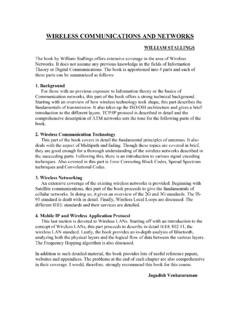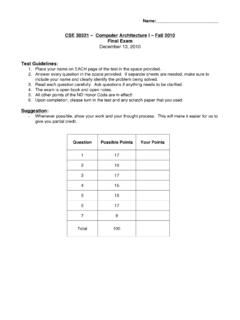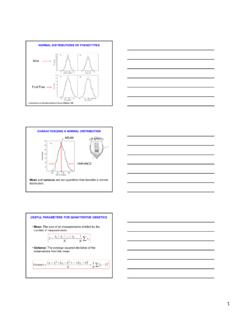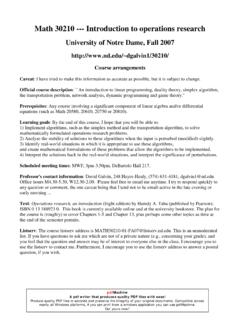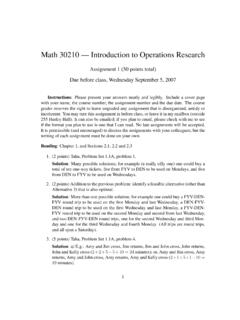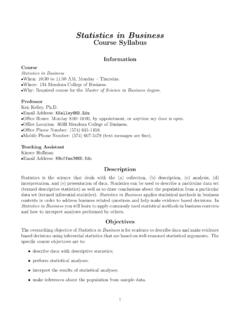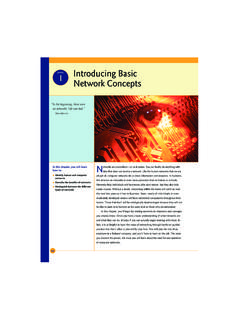Transcription of Chapter 9: Time Synchronization
1 1! Chapter 9: Time Synchronization 2!Fundamentals of Wireless Sensor Networks: Theory and Practice Waltenegus Dargie and Christian Poellabauer 2010 John Wiley & Sons Ltd. Chapter 9: Roadmap The time Synchronization problem! Time Synchronization in wireless sensor networks! Basic techniques for time Synchronization ! Time Synchronization protocols!3!Fundamentals of Wireless Sensor Networks: Theory and Practice Waltenegus Dargie and Christian Poellabauer 2010 John Wiley & Sons Ltd. Clocks and the Synchronization Problem Common time scale among sensor nodes is important for a variety of reasons! identify causal relationships between events in the physical world! support the elimination of redundant data! facilitate sensor network operation and protocols! Typical clocks consist of quartz-stabilized oscillator and a counter that is decremented with every oscillation of the quartz crystal!
2 When counter reaches 0, it is reset to original value and interrupt is generated! Each interrupt (clock tick) increments software clock (another counter)! Software clock can be read by applications using API! Software clock provides local time with C(t) being the clock reading at real time t! Time resolution is the distance between two increments (ticks) of software clock!2!4!Fundamentals of Wireless Sensor Networks: Theory and Practice Waltenegus Dargie and Christian Poellabauer 2010 John Wiley & Sons Ltd. Clock Parameters Clock offset: difference between the local times of two nodes! Synchronization is required to adjust clock readings such that they match! Clock rate: frequency at which a clock progresses! Clock skew: difference in frequencies of two clocks! Clock rate dC/dt depends on temperature, humidity, supply voltage, age of quartz, etc.
3 , resulting in drift rate (dC/dt-1)!5!Fundamentals of Wireless Sensor Networks: Theory and Practice Waltenegus Dargie and Christian Poellabauer 2010 John Wiley & Sons Ltd. Clock Parameters Maximum drift rate given by manufacturer (typical 1ppm to 100ppm)! Guarantees that: Drift rate causes clocks to differ even after Synchronization ! Two synchronized identical clocks can drift from each other at rate of at most 2 max! To limit relative offset to seconds, the resynchronization interval sync must meet the requirement:! 1 dCdt 1+ sync 2 max6!Fundamentals of Wireless Sensor Networks: Theory and Practice Waltenegus Dargie and Christian Poellabauer 2010 John Wiley & Sons Ltd. Clock Parameters C(t) must be piecewise continuous (strictly monotone function of time)! clock adjustments should occur gradually, , using a linear compensation function that changes the slope of the local time!
4 Simply jumping forward/backward in time can have unintended consequences! time-triggered events may be repeated or skipped!3!7!Fundamentals of Wireless Sensor Networks: Theory and Practice Waltenegus Dargie and Christian Poellabauer 2010 John Wiley & Sons Ltd. Time Synchronization External Synchronization ! clocks are synchronized with external source of time (reference clock)! reference clock is accurate real-time standard ( , UTC)! Internal Synchronization ! clocks are synchronized with each other (no support of reference clock)! goal is to obtain consistent view of time across all nodes in network! network-wide time may differ from external real-time standards! External Synchronization also provides internal Synchronization ! Accuracy: maximum offset of a clock with respect to reference clock!
5 Precision: maximum offset between any two clocks! If two nodes synchronized externally with accuracy of , also synchronized internally with precision 2 !8!Fundamentals of Wireless Sensor Networks: Theory and Practice Waltenegus Dargie and Christian Poellabauer 2010 John Wiley & Sons Ltd. Why Time Synchronization in WSNs? Sensors in WSNs monitor objects and events in the physical world! Accurate temporal correlation is crucial to answer questions such as! how many moving objects have been detected?! what is the direction of the moving object?! what is the speed of the moving object?! If real-time ordering of events is t1<t2<t3, then sensor times should reflect this ordering: C1(t1)<C2(t2)<C3(t3)!9!Fundamentals of Wireless Sensor Networks: Theory and Practice Waltenegus Dargie and Christian Poellabauer 2010 John Wiley & Sons Ltd.
6 Why Time Synchronization in WSNs? Time difference between sensor time stamps should correspond to real-time differences: =C2(t2)-C1(t1)=t2-t1! important for data fusion (aggregation of data from multiple sensors)! Synchronization needed by variety of applications and algorithms! communication protocols (at-most-once message delivery)! security (limit use of keys, detect replay attacks)! data consistency (caches, replicated data)! concurrency control (atomicity and mutual exclusion)! medium access control (accurate timing of channel access)! duty cycling (know when to sleep or wake up)! localization (based on techniques such as time-of-flight measurements)!4!10!Fundamentals of Wireless Sensor Networks: Theory and Practice Waltenegus Dargie and Christian Poellabauer 2010 John Wiley & Sons Ltd.
7 Challenges for Time Synchronization Traditional protocols ( , NTP) are designed for wired networks! WSNs pose a variety of additional challenges! Environmental effects! sensors often placed in harsh environments! fluctuations in temperature, pressure, humidity! Energy constraints! finite power sources (batteries)! time Synchronization solutions should be energy-efficient! Wireless medium and mobility! throughput variations, error rates, radio interferences, asymmetric links! topology changes, density changes! node failure (battery depletion)! Other challenges! limited processor speeds or memory (lightweight algorithms)! cost and size of Synchronization hardware (GPS)!11!Fundamentals of Wireless Sensor Networks: Theory and Practice Waltenegus Dargie and Christian Poellabauer 2010 John Wiley & Sons Ltd.
8 Synchronization Messages Pairwise Synchronization : two nodes synchronize using at least one message! Network-wide Synchronization : repeat pairwise Synchronization throughout network! One-way message exchange:! single message containing a time stamp! difference can be obtained from (t2-t1)=D+ (D=propagation delay)!12!Fundamentals of Wireless Sensor Networks: Theory and Practice Waltenegus Dargie and Christian Poellabauer 2010 John Wiley & Sons Ltd. Synchronization Messages Two-way message exchange:! receiver node responds with message containing three time stamps! assumption: propagation delay is identical in both directions and clock drift does not change between measurements! D=(t2 t1)+(t4 t3)2 offset=(t2 t1) (t4 t3)25!13!Fundamentals of Wireless Sensor Networks: Theory and Practice Waltenegus Dargie and Christian Poellabauer 2010 John Wiley & Sons Ltd.
9 Receiver-Receiver Synchronization So far: sender-receiver approaches! Receiver-receiver: multiple receivers of broadcast messages exchange their message arrival times to compute offsets among them! Example: 2 receivers; 3 messages (1 broadcast, 2 exchange messages)! No time stamp in broadcast message required!14!Fundamentals of Wireless Sensor Networks: Theory and Practice Waltenegus Dargie and Christian Poellabauer 2010 John Wiley & Sons Ltd. Nondeterminism of Communication Latency Several components contribute to total communication latency! Send delay: ! generation of Synchronization message! passing message to network interface! includes delays caused by OS, network protocol stack, device driver! Access delay:! accessing the physical channel! mostly determined by medium access control (MAC) protocol!
10 Propagation delay:! actual time for message to travel to sender (typically small)! Receive delay:! receiving and processing the message! notifying the host ( , interrupt)!15!Fundamentals of Wireless Sensor Networks: Theory and Practice Waltenegus Dargie and Christian Poellabauer 2010 John Wiley & Sons Ltd. Nondeterminism of Communication Latency 6!16!Fundamentals of Wireless Sensor Networks: Theory and Practice Waltenegus Dargie and Christian Poellabauer 2010 John Wiley & Sons Ltd. Reference Broadcasts Global Positioning System (GPS) is a well-known global source of time! time measured from epoch started at 0h January 6, 1980 UTC! unlike UTC, GPS not perturbed by leap seconds! GPS is ahead by 15 seconds (and increasing)! Terrestrial radio stations! WWV/WWVH & WWVB (National Institute of Standards & Technology)!
